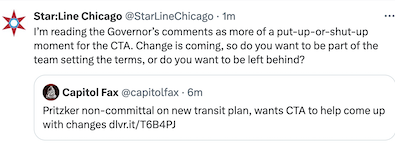* Sun-Times…
State legislators are proposing legislation that would create a transit agency to oversee public transit across northeastern Illinois and provide an additional $1.5 billion in annual funding for public transportation.
State Sen. Ram Villivalam, D-Chicago, and state Rep. Eva-Dina Delgado, D-Chicago, have introduced the Metropolitan Mobility Authority Act, which would create the Metropolitan Mobility Authority to oversee all public transit operations and replace the Regional Transportation Authority.
They say the measure aims to avoid overlap and competition for money between the RTA, Chicago Transit Authority, Pace and Metra — which they said has led to a delay in integrated fares — and instead provide “coordinated” services. The metro area once had just the RTA and CTA, and Metra and Pace were created later. […]
RTA Chair Kirk Dillard said the agency was open to changes but adequate funding had to come along with that for the “chronically underfunded” system.
“We welcome discussion on reforms that strengthen coordination, efficiency, and accountability across the regional transit system,” Dillard said a statement to the Chicago Sun-Times. “But reforms must come with the necessary funding to upgrade service and maximize transit’s impact on the region’s economy, climate, and access to opportunity for all residents.”
* Tribune…
Some of the transit agencies have pushed back on the idea. [CTA President Dorval Carter], in a September letter to CMAP about the organization’s proposals, said focusing on how transit is governed instead of funding would be a “grave mistake” and a “near impossible task to practically accomplish” because providing service is complex.
“To attribute the region’s challenges to anything other than a funding shortage is to perpetuate a narrative that will — at best — serve as a distraction to the funding crisis we face, and — at worst — deepen the disparities of opportunity and access plaguing our region by claiming that it is governance and management issues that are the premier drivers of our challenges,” Carter wrote.
The way transit systems are funded, now, is “discriminatory,” Carter said in the letter, tying funding issues to race. The CTA historically has been underfunded under a 40-year-old deal reached by a downstate- and collar county-controlled Illinois General Assembly when Harold Washington was elected as the city’s first Black mayor, he said.
The deal was intended to ensure the CTA and the mayor’s influence “was always controlled ultimately by other entities,” Carter wrote. He cited the creation of a “suburban-controlled” RTA and a funding formula that sends 49% of the region’s transportation funding to the CTA, which provides 80% of transit trips.
* Gov. Pritzker was asked about this proposal at an unrelated event…
I have not read the bill, I’ve only read the reporting on the bill.
And obviously, there are changes that will have to take place as we move forward in thinking about the funding cliff and thinking about how better to operate the transit systems in the region. So you know, I like that there’s creativity coming out of the General Assembly.
I also think we need to make sure that we’re listening to other organizations, including the CTA, who ought to be coming forward with more about what changes need to take place.
So I’m pleased that there’s movement on this front but I you know, I don’t not endorsing any particular plan yet
Please pardon all transcription errors.
…Adding… Interesting point…

…Adding… Daily Herald…
“What we hope is included is a long-term fiscal solution that doesn’t disrupt progress and reflects the real-life service needs of our region,” Pace spokeswoman Maggie Daly Skogsbakken said.
“Pace’s current governance structure allows us to be nimble and responsive to local needs, and it is feared that a governance consolidation would negatively impact commuters.
“Changes must reflect the actual service needs of our region and address the real problem, which is a historic lack of investment in our transit system, especially in the suburbs,” she added
14 Comments  
|
* Tribune…
Logan women’s prison would be moved onto the same site as the men’s maximum security Stateville Correctional Center as part of a plan to rebuild both facilities, according to a proposal the Illinois Department of Corrections has submitted to a state commission.
The recommendations from IDOC come a little more than a month after Gov. J.B. Pritzker unveiled a plan to rebuild Stateville and Logan prisons. The governor said the project would cost close to $1 billion, while offering few other details.
The proposal to move Logan from its longtime location in Lincoln, Ill., about 30 miles northeast of Springfield, to the Stateville property in Crest Hill, near Joliet, was included in a report IDOC provided to the Commission on Government Forecasting and Accountability on Friday, part of a lengthy facilities closure process mandated by the state. […]
The IDOC recommendations sent Friday maintain that the Department does not expect any employees to lose their jobs in the process unless they voluntarily choose a layoff. More than 450 people are staffed at Logan Correctional Center and 939 are employed at Stateville, IDOC said.
* From the IDOC report to COGFA…
IDOC is considering moving Logan from its present location in Lincoln, IL. Specifically, as the Department’s planning has progressed, the current preferred plan for Logan is to build on available ground at Stateville Correctional Center in Crest Hill, Illinois. A move to Crest Hill would permit a more regionalized approach for the women’s facilities by providing a northern facility to pair with the already centrally located facility in Decatur. […]
As of April 15, 2024, the Department’s individual in custody population at Logan is 1081. There are only 1541 female individuals in custody within the entire Department. The Department has deemed Logan necessary to close due to its crumbling infrastructure, outdated design, and significant need for capital investment. Specifically, there are approximately $116 million of capital projects that are required for Logan to remain open and operational long-term. IDOC intends to continue to house the individuals in custody at Logan until the rebuild is complete as long as it is safe to do so. However, in the event the conditions of Logan continue to deteriorate, or a part of its critical infrastructure fails, IDOC may need to relocate all individuals in custody at Logan prior to the completion of the rebuild. […]
Logan Correctional Center serves a multifaceted population consisting of reception and classification, protective custody, general population and mental health units. Nearly 1,000 of Logan’s current housing unit beds were built more than 90 years ago for a mental health population. Most of the buildings at Logan, including most of its housing units were built nearly a century ago for patient wards in a mental health institution. These units do not meet the ideal standards of modern correctional practices, are not supportive of a rehabilitative environment and complicate the overall delivery of required services. Additionally, the facility is fueled by a coal-fired plant that dates back to 1930.
* Also this…
Ability of the current and potential communities to provide the infrastructure to support functions and employees.
Since 2010, Logan County has seen a population decline of 2,715 (1%). The county is 90% white, 8% American Indian/Native American, and 1% Asian. Additionally, approximately 20% of residents aged 25 or older hold at least a bachelor’s degree.
Since 2010, Will County, where the Department is seriously considering building the new Logan facility, has experienced significant population growth, with an increase of over 20,000 residents, bringing the total population to approximately 700,000. This demographic expansion includes a diverse population, with 13% identifying as African American and 20% as Hispanic or Latino. Additionally, over 35% of residents aged 25 or older hold at least a bachelor’s degree.
These demographic factors are essential as they ensure a robust talent pool from which to recruit and fill positions, particularly in specialized fields such as medical and social work. Additionally, Will County’s proximity to other collar counties and Cook County enhances access to a broad network of providers and vendors, further supporting the facility’s operational needs and the rebuild process.
* Costs…
The Department estimates that it could take up to approximately $7 million to complete the transition for Logan and Stateville Correctional Centers. Please see below:
o Relocation of Individuals in Custody - $76,200
o Staff Redeployment - $603,800
o Legal Costs - $402,500
o Operational Adjustments at Receiving Facilities - $5,750,000
o Grand Total - $6,832,500
These expenses, once incurred, would be paid from the Department’s operating budget, which is appropriated from the General Revenue Fund
IDOC’s Stateville Correctional Center report is here.
…Adding… Gov. Pritzker was asked about this at an unrelated event…
This is still being worked out. There will be hearings, as you know, this is part of the process. But you have to understand that we have to make changes. This has to happen. Changes have to take place because these prisons have not been upgraded or renovated in many, many years. Many of them are very, very old. and particularly we’re talking about Stateville and Logan.
And so, you know, we’re going to be careful about it, especially because we want to protect not only the corrections officers, but the people who reside in or serving their sentences. And unfortunately, over many years, the state has neglected to do anything about the conditions in these prisons. We’re stepping up and actually making a proposal and then putting the money forward to do the right thing. And I think that should be commended. And I also think that in protecting the people who work there, that’s something that I deeply care about. And we’re going to do that in all of the processes that are lending themselves right now. So I think this is the right way to go. We’re doing it the right way.
Please pardon all transcription errors.
24 Comments  
|
|
Comments Off  
|
* Gov. Pritzker was asked today about the financial aspect of the Bears’ stadium plan…
Oh, it is more than what they put forward. I think all of you are starting to report on that. I mean, they want infrastructure dollars on top of what they’re asking for in funding.
They’re asking to keep all of the revenue from other events that might take place at the stadium. You know, if there’s a Beyoncé concert, they want all of that revenue too, and everything else that might happen there. So yeah, I mean, there are aspects of this that are, you know, probably non-starters.
Having said that, you know, always open to a conversation but as I’ve said, the priorities of the people of Illinois are not building stadiums, right?
It’s really about for example, birth equity and building birth centers for people in Black and Brown communities, just as one example. But we have important things we need to invest in for the future of the state and again, stadiums in my mind don’t rank up in the top tier of those.
[Asked about state revenues for other purposes being used for the stadium]
You’re saying dollars that would come into the state of Illinois for other purposes and kind of making sure that those go to this? No. I mean, the truth is that if we have dollars coming in to support parks, for example, in Chicago or in the state of Illinois, it strikes me that it wasn’t contemplated that those dollars would go to a ballpark [chuckles], but rather parks for children and families and neighborhoods and making sure that the city of Chicago has beautiful places for people to go and enjoy themselves without having to spend hundreds of dollars on tickets and and other things.
[Asked about whether it would be preferable to use revenues rather than borrowing]
You mean if like manna from Heaven, a check arrived and it said ‘Give this to the Chicago Bears’ would I want to do that, is that your…?
[If there happened to be one of those funds, would that be preferable to borrowing money]
I’m unaware. If you know of one of those funds, yeah, let me know. I’m unaware of one.
Please pardon all transcription errors.
…Adding… Pritzker also had this to say when first asked about the Bears plan this afternoon…
Well, I have a few words I’d like to say like, for example, what about women’s sports? Very little has been talked about the Red Stars, for example, who asked to be heard on this subject. In addition to that, as you know, the White Sox have asked for support for a stadium for them, but the proposal that was put forward, didn’t include them and takes all the money that’s available and more just for the Bears. So, I think the proposal, again, I’m skeptical of the proposal that was put forward and and I’m even more skeptical of the ability to get enough votes for it in the General Assembly.
34 Comments  
|
Today’s quotables
Thursday, Apr 25, 2024 - Posted by Rich Miller
* House Speaker Chris Welch yesterday when asked about the Chicago Bears stadium plan…
Welch: Let me say this. I’m going to say to you publicly what I said to Kevin Warren privately last week: If we were to put this issue on the board for a vote right now, it would fail and it would fail miserably. There is no environment for something like this today.
Now in Springfield, environments change. Will that environment change within the next 30 days? I think that’s highly unlikely. You know, I think there’s a whole lot of Chicago Bears fans in the General Assembly, but our priorities are pretty clear. And we, starting next week, have one month to pass another balanced budget to, continue the positive outlook that Moody’s talked about yesterday with regard to our financial health. And I can tell you, that’s something that we have front and center as a top priority for us right now. Taking care of working families across this state is the top priority for us right now.
Q: [Does he envision any scenario where this could happen?]
Welch: Again, environments do change in Springfield. I mean, peoples’ minds can be convinced, there’s gonna be a lot of conversations. But as the governor noted, there’s three teams in Chicago. You have the Bears, the White Sox and the Chicago Red Stars, the women’s soccer team. They’re all wanting a share of this pot. And I think you have to seriously have those conversations as well. You know, in sports, equity is very important. Equity is at the center of everything we do in the House. And so I don’t think anyone can be left out of that conversation. And so, I think what’s happening today is really the kickoff, no pun intended, of some conversations to be had.
Discuss.
…Adding… Mayor Brandon Johnson talked to NBC Sports Chicago after yesterday’s presser…
How does Johnson respond to the lack of alignment between the city of Chicago and the state of Illinois?
“Well, I run the city of Chicago,” Johnson said. “I mean, that’s my responsibility to people in Chicago voted for me to run the city. And what the city has made very clear is that the public use and the public benefits to transform the lakefront. That has always been my goal. It’s not about just keeping the bears in the city of Chicago, which we have a commitment from the Bears to remain in Chicago, but it’s also about the transformation that exists there.
“Now, as far as the next steps, of course, to engage the speaker of the House, the Senate president to engage the governor, to engage the people of Chicago as a whole. That is also part of the process. But we needed to make sure that the Bears organization and my administration were on the same page. And when it comes to investing in this moment, creating hundreds of thousands of jobs, we’re talking about $3.5 billion of income in our workers.”
Full video is here.
48 Comments  
|
|
 Support CapitolFax.com
Support CapitolFax.com
Visit our advertisers...

 ...............
...............
 ...............
...............
 ...............
...............
 ...............
...............
 ...............
...............


|
   
|
Hosted by MCS
SUBSCRIBE to Capitol Fax
Advertise Here
Mobile Version
Contact Rich Miller
|















